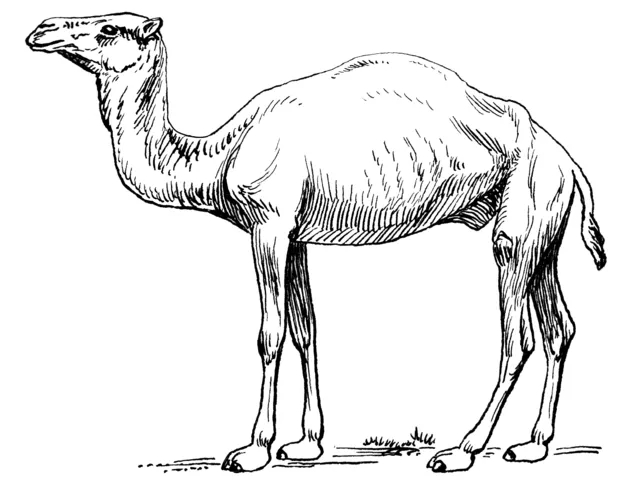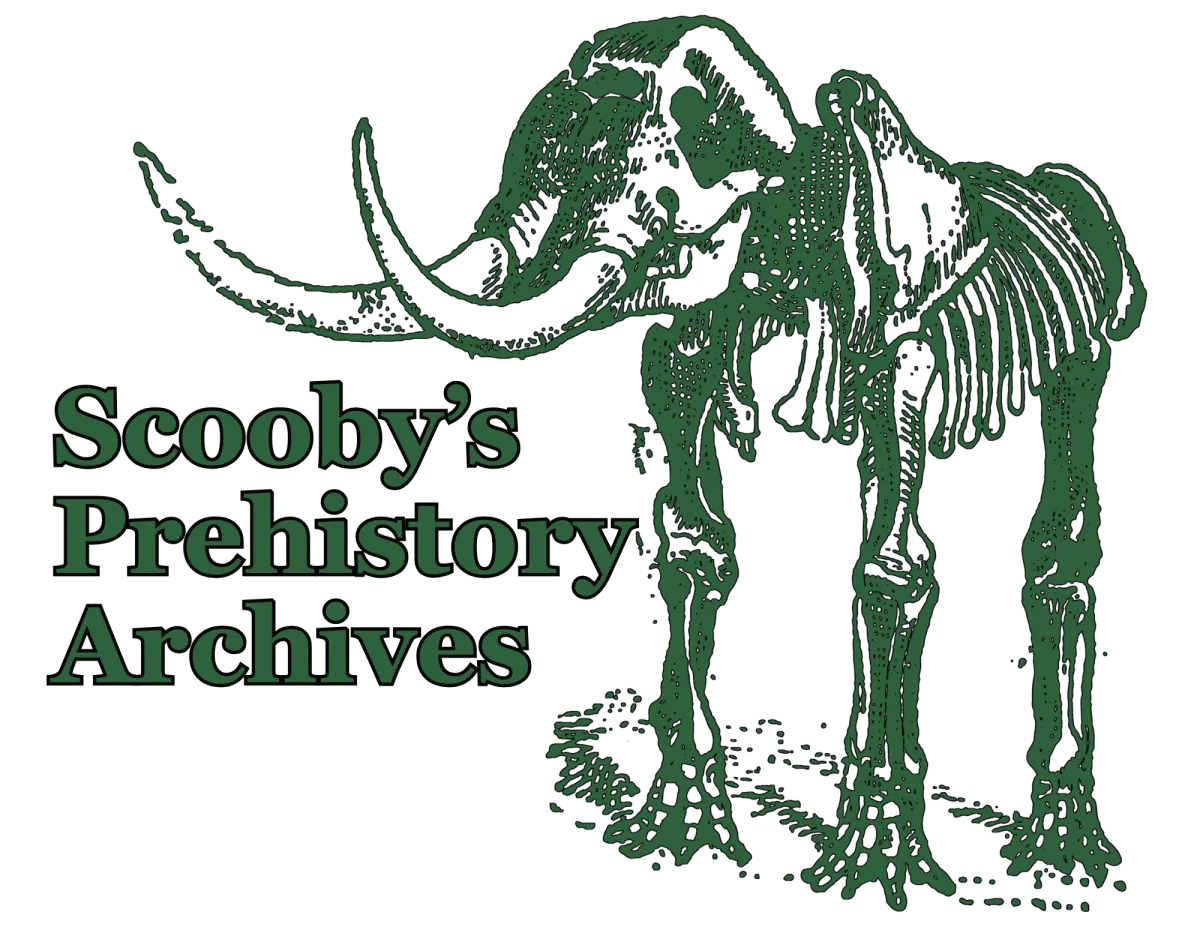
Paracamelus: The Granddaddy of Modern Camels
Modern camels remain one of the most recognizable and unique mammals alive today. There are three humped species, all of which are within the genus Camelus in the tribe Camelini. These include the domestic dromedary camel (C. dromedarius), the domestic bactrian camel (C. bactrianus), and the wild bactrian camel (C. ferus). A few more species of Camelus have existed, including the giant C. knoblochi, but they went extinct during the Pleistocene epoch. Camelus is one of two extant genera within the camel family of Camelidae, the

other being Lama in the tribe Lamini. The South American Lama contains four species: the domestic llama (L. glama) and alpaca (L. pacos) and the wild guanaco (L. guanicoe) and vicuña (L. vicugna).
A natural question arises: why are the only living Camelids found so far from each other? The answer lies in the origin of the group, over 45 million years ago in the Eocene epoch. Camels are artiodactyls, which is a group of mammals containing modern pigs, cattle, giraffes, and even whales. They are characterized as placing their weight equally on two toes of each foot. In the Eocene, the first artiodactyls with some camel-like features would begin to appear in North America. From there, Camelidae diversified into a variety of subfamilies, including the Camelinae, which contains Lama and Camelus. The key feature that identifies members of Camelidae is the presence of two toes and footpads. Some notable members include Aepycamelus, a lamine with a giraffe-like neck, Camelops, the last of the North American camelines, and Hemiauchenia, which migrated to South America to give rise to the modern lamines. If Hemiauchenia gave rise to the lamines by moving south, then there must be another prehistoric camel that paved the way for the three living camel species observed today. That cameline is Paracamelus.

Paracamelus first appeared in North America during the late Miocene, around 8 million years ago. Within a couple million years, the genus had already spread to Asia by way of the Bering land bridge. By the early Pliocene epoch, over 5 million years ago, the Bering strait had now opened, leaving different groups of Paracamelus on either side. Prior to this early opening of the waterway, Paracamelus had already spread all the way to Spain, as evidenced by P. aguirrei from the latest stages of the Miocene. Later, by the middle part of the Pliocene, the Earth was experiencing a warm period and Paracamelus was able to move towards the arctic circle. In Yukon, Canada, an indeterminate Paracamelus species is known. Around the same time, P. gigas is known from what is now northern China. Indeed, by the Pliocene epoch, Paracamelus was very widespread, with species everywhere from North America to Europe and Africa. All told, according to Liu et al. in 2023, there are twelve generally recognized species: P. gigas, P. sibiricus, P. alutensis, P. khersonensis, P. bessarabiensis, P. praebactrianus, P. alexejevi, P. longipes, P. aguirrei, P. tromovi, P. minor, and P. qiui.
Physically, Paracamelus was a very large mammal. Many species of the genus, including P. aguirrei and P. gigas were larger than modern-day camels, with P. gigas reaching heights of about 8 feet (2.4 meters). This figure is compared to the maximum male dromedary height of about 6.6 feet (2 meters), which is closer to species such as P. alexejevi. Further still, some species were smaller than modern camels, such as P. alutensis.

Paracamelus is thought to be the direct ancestor of Camelus, which likely arose anagenetically. Anagenesis is a term used to describe the direct evolution of one species to the other, generally without branching out. Some Paracamelus species themselves also arose in this manner; for instance, P. gigas likely arose from the smaller P. alexejevi in eastern Asia.This position, taken from research by Wei Dong et al. in 2024, contradicts with century-old ideas of P. gigas arising first in North America from the giant camel Megatylopus. As of now, the closest relative of Paracamelus- outside of Camelus- is uncertain. The anagenetic rise of Camelus itself is also uncertain. The differentiating feature between the two genera is the presence of the third premolar tooth in Paracamelus, which Camelus lost. The original interpretation from the 1930s was that P. gigas was the direct ancestor of C. knoblochi, which further led to C. bactrianus. However, Geraads et al. (2021) described remains of what is now the earliest known species of the modern Camelus genus from Ethiopia, C. grattardi. This earliest record of Camelus dates back to the very end of the Pliocene or the earliest Pleistocene (around 2.2-2.9 million years ago). This species is the most basal, or closest to the bottom of the family tree, of Camelus. It can then be reasonably assumed that C. grattardi diversified into the other known species of Camelus.
However, as Wei Dong et al. demonstrate, there is an issue of geography and timing for the different species of Camelus. Specifically, succeeding species of Camelus showed up in varying areas of Africa and Asia, which seems to imply that camels migrated vast distances. While not impossible, Wei Dong et al. view this implication as being unlikely to occur at the frequency that the fossils show. It is important to also consider that the fossil record, while impressive, is not extensive with any organisms, and particularly with old world camelid finds. As such, they hold on to the older view of C. knoblochi evolving from P. gigas, which later diversified further. All considered, the most parsimonious (simplest) evolutionary origin of Camelus is likely that the genus began in Ethiopia with C. grattardi, which then further diversified as some populations migrated throughout the continents. Until more Paracamelus or Camelus fossils are uncovered, there will be some uncertainty.

As for the extant camel species, C. dromedarius, C. bactrianus, and C. ferus, it seems as though C.
dromedarius diverged from the two bactrian species much later than some early estimates stated. According to Geraads et al., various molecular estimates have placed the age of divergence between C. dromedarius and the bactrian lineage as anywhere between 4 million and 8 million years ago. The more extreme estimates may completely contradict the idea that Camelus evolved in the old world at all, which the authors discount as unlikely. Again, due to the sparse nature of fossil camels in Asia and Africa, there is some uncertainty on the timing of the evolution of certain species. Geraads et al. instead claims that the two groups diverged sometime in the Pleistocene, likely less than 2 million years ago. Modern evidence to this claim is that hybrids between C. dromedarius and C. bactrianus can be fertile at relatively high rates. No artidactyl hybrids between species that diverged before the Pleistocene are known to be fertile. Another consideration is the splitting of C. ferus and C. bactrianus. The former is not the wild form of the latter. In fact, the two diverged well before the domestication of C. bactrianus around 3,000 BC. Today, aside from certain feral populations, both C. dromedarius and C. bactrianus exist solely domestically. Meanwhile, C. ferus still roams wild in pockets of northern China and southern Mongolia. Unfortunately, they are critically endangered. If they are not protected, the world may be without truly wild camels for the first time in millions of years.
Paracamelus is noteworthy for being the first camels to venture into Asia, spreading all throughout the old world. As the old North American camels disappeared, the new genus of Camelus arose and diversified. Without this initial foray into a new land, humped camels would no longer exist.
Anyway, happy humpday!

Sources:
Buckley, Michael, et al. “Collagen Sequence Analysis of Fossil Camels, Camelops and C.f. Paracamelus, from the Arctic and Sub-Arctic of Plio-Pleistocene North America.” Journal of Proteomics, vol. 194, Mar. 2019, pp. 218–225, https://doi.org/10.1016/j.jprot.2018.11.014. Accessed 7 June 2021.
Caballero, Óscar, et al. “The Autopodial Skeleton of Paracamelus Aguirrei (Morales 1984) (Tylopoda, Mammalia) from the Late Miocene Site of Venta Del Moro (Valencia, Spain).” Journal of Iberian Geology, vol. 47, no. 3, 11 Jan. 2021, pp. 483–500, https://doi.org/10.1007/s41513-020-00144-x. Accessed 4 May 2024.
Dong, Wei, et al. “A Skull of Early Pleistocene Paracamelus Gigas (Artiodactyla, Mammalia) from Luotuo Hill in Dalian, Northeast China.” Vertebrata PalAsiatica, vol. 62, no. 1, 16 Jan. 2024, www.researchgate.net/publication/377413088_A_skull_of_Early_Pleistocene_Paracamelus_gigas_Artiodactyla_Mammalia_from_Luotuo_Hill_in_Dalian_Northeast_China, https://doi.org/10.19615/j.cnki.2096-9899.230616.
Hirayama Ikuo Silk Road Museum. “To the Remains of Palmyra·Night|平山郁夫シルクロードコレクション.” Silkroad-Museum-Collection.jp, 2025, silkroad-museum-collection.jp/to-the-remains-of-palmyra%C2%B7night/. Accessed 20 Sept. 2025.
Ji, R., et al. “Monophyletic Origin of Domestic Bactrian Camel (Camelus Bactrianus) and Its Evolutionary Relationship with the Extant Wild Camel (Camelus Bactrianus Ferus).” Animal Genetics, vol. 40, no. 4, Aug. 2009, pp. 377–382, https://doi.org/10.1111/j.1365-2052.2008.01848.x.
Lea, Tara. “Camel Breeds and Species Explained.” Camelchannel.com, 2024, www.camelchannel.com/blog/Camel-Breeds-dromedary-bactrian.
Liu, Wen-hui, et al. “Revision of the Late Cenozoic Camelids from the Yushe Basin, Shanxi, with Comments on Chinese Fossil Camels.” Quaternary Sciences, vol. 43, no. 3, 30 May 2023, pp. 712–751, www.researchgate.net/publication/371161509_Revision_of_the_Late_Cenozoic_camelids_from_the_Yushe_Basin_Shanxi_with_comments_on_Chinese_fossil_camels, https://doi.org/10.11928/j.issn.1001-7410.2023.03.05.
Rybczynski, Natalia, et al. “Mid-Pliocene Warm-Period Deposits in the High Arctic Yield Insight into Camel Evolution.” Nature Communications, vol. 4, no. 1, 5 Mar. 2013, https://doi.org/10.1038/ncomms2516.
Sala, Renato. “The Domestication of Camel in the Literary, Archaeological and Petroglyph Records.” Journal of Arid Land Studies, vol. 26, no. 4, 1 Jan. 2017, pp. 205–211, https://doi.org/10.14976/jals.26.4_205. Accessed 10 Dec. 2023.
Image at the Bronx Zoo by Richard Gutierrez

